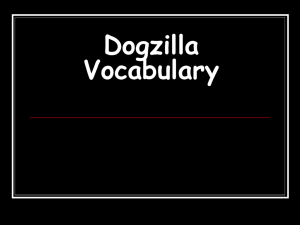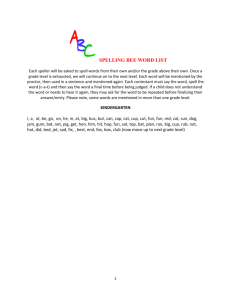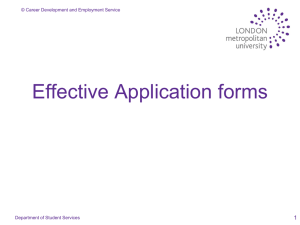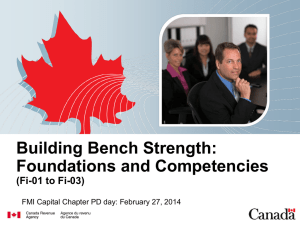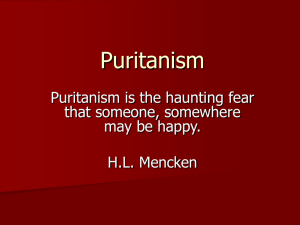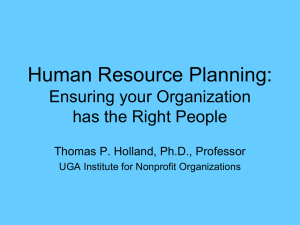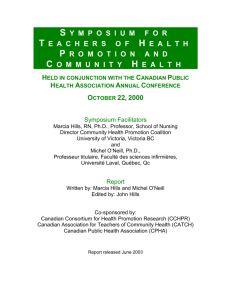Unit 7 A
advertisement
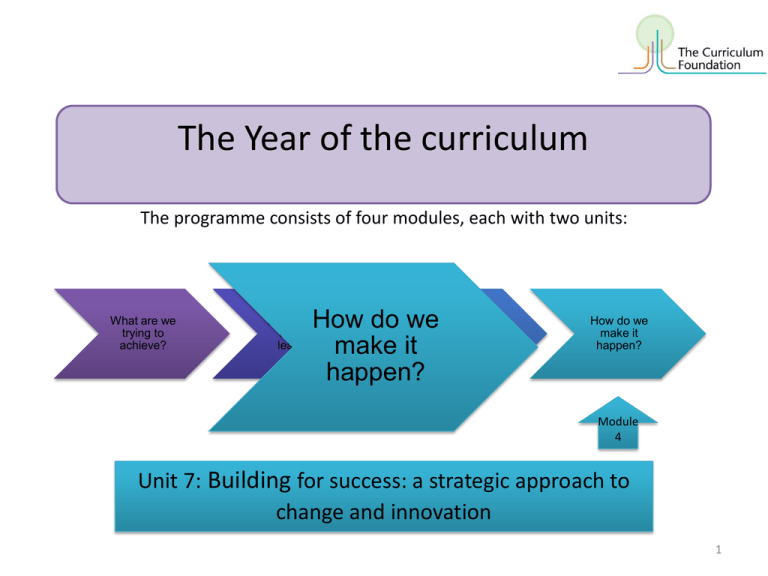
The Year of the curriculum The programme consists of four modules, each with two units: What are we trying to achieve? How shall we How do we evaluate success? make it happen? How shall we organise learning? How do we make it happen? Module 4 Unit 7: Building for success: a strategic approach to change and innovation 1 Welcome to Unit 7 Building for success: a strategic approach to change and innovation 1. Introduction a. Overview and rationale b. Making it happen in lessons 1. Introducing the new curriculum a. Leading and managing change b. Practicalities and considerations c. Securing commitment and quality 2. Embedding the new curriculum a. b. c. Systems, policies and routines Consistent messages Assessing breadth of learning 2 Part 1 Introduction © Curriculum Foundation 3 a. Overview and rationale The final module of this programme is much more practical than the previous three. Hence the line-up of ‘suspects’ (below) is shorter than usual. In this module (the last two units), we shall be considering how to make sure that the curriculum you have designed bears fruit in terms of the deep learning we want for all our young people. So this module concerns how the documented curriculum is translated into the pedagogy and the learning experiences which will ensure the curriculum aims are achieved. No matter how good the quality of the curriculum, it would not succeed without high quality learning routinely taking place. Hence the practical focus of this unit, on what must be done to align aims and practice and what must be avoided. 4 In unit 7 we tackle the strategy for implementing the new curriculum. Of course, this has its own challenges but also much in common with the strategic planning for any major change. In unit 8 there is a focus on the paradigm shift which is necessary if the new curriculum is really going to have the impact we want. If learners are to take responsibility for their own learning, the curriculum is democratised. It is ‘owned’ by both education professionals and consumers (students, families, communities, employers) and this has significant implications. But first, have you done your Unit 6 homework? Have you thought about your benchmarks? These will be important as you implement the new curriculum. As always, remember to share your work at YOC@NUT.org.uk 5 Do you remember this from Unit 1? UNESCO’s International Bureau of Education considers three interrelated dimensions of the curriculum: • the intended or official curriculum as defined in guidelines, frameworks and guides that specify what students are expected to learn and should be able to do; • the implemented curriculum that is actually taught in the classroom, including how it is delivered and who teaches it; • and the attained curriculum that represents what students have actually learned. They go on to point out that the challenge is ensuring coherence and congruence between curriculum policy documents, the actual pedagogical process and learning outcomes. 6 We all know from experience that…. the expected learning set out in documentation, what is actually taught in the classroom and what students really learn in their lessons …..can be three very different things. So the considerable challenge we face as we implement the new curriculum is to ensure this is not the case and students really do learn what we have planned so carefully for them. 7 The Final Hurdle Of course, there does not have to be a complete match between expected learning and actual learning outcomes. Ideally students will be inspired independent learners and will eagerly take their learning beyond that detailed in the curriculum. However, the importance of the implementation phase cannot be overstated. If we should fall at this final hurdle we would not reach the finishing line and our ambitions for our learners would not be realised. This unit focuses on good practice and on the pitfalls to be avoided to ‘make it happen’. 8 b. Making it Happen in Lessons Schemes of Learning or Learning Plans The key tools for translating intended learning as set out in curriculum documents into actual learning in lessons are schemes of learning or schemes of work. These are often set out at three levels: Long-term plans or overviews cover the full range of learning and progression across a year or key stage, usually without much detail. Medium-term plans cover sub-sections of the long-term plan and provide greater detail about the learning objectives. Short-term plans break the learning down further to the level of individual lessons. Crucially, if the new curriculum is to have the impact we desire, what happens in lessons will have to reflect all the decisions we made which fed into the list of curriculum principles. If values, attitudes, skills and competencies are to be routinely taught in the same way as subject knowledge, they must be securely transmitted through long and medium-term plans into learning objectives and outcomes at lesson level. Schools therefore need to consider the extent to which the layout of their current planning documentation needs to be rethought. 9 Activity 1 Review your planning documentation. Is it fit for purpose? • Does long term planning take account of coverage of content and progression in learning across the year, from one year to the next and across key stages? • Do medium term or unit plans (see next slide) include coverage of knowledge, skills, attitudes, values and competencies? • Do they provide guidance on aligned learning activities? • Is assessment considered at the planning stage? 10 Schools will design their documentation according to their particular needs and circumstances. This example of a mid-term plan covers a short (3 lesson) unit of learning. It is provided here to promote discussion and not as a blueprint. Key points to note: • There are three distinct categories of learning objectives • There are Bloom-style prompts to take knowledge and understanding to higher levels • There is a focus on both subject competencies and generic competencies Year 4 Science Topic 3: Hygiene and First Aid 3 lessons Key Subject Competency To be able to ……. Learning Activities Learning Objectives Knowledge and understanding · · · · · Know … State … Recall … Identify … Understand … Skills · · · · · · · · · Apply knowledge … Analyse … Evaluate … Create … Explain … Describe … Carry out an investigation … Observe … Research … Attitudes and values · · · Appreciate the importance of … Show concern … Show respect for … · · · · · · Devise an experiment … Observe through magnifying glass … Discuss reasons for … Find out about … Role-play … Make a group presentation … Contribution to the generic competencies: critical thinking …; investigation …; co-operation …; communication Links to other subjects: Assessment approach: Materials: 11 Learning Plans: Consistency and Quality The documentation for learning plans must serve the needs of the whole school, of teams and of individual teachers. A collaborative design process can ensure that these needs are met at every level while setting a quality standard expected of all. Deviation from the standard is wise only where there is a particular additional risk or issue to address (eg Health and Safety in Science). It is important plans demonstrate universal commitment to consistent whole school priorities, aims, values, attitudes etc. 12 Activity 2 • You have reviewed your planning documentation and thought about how it could be improved. Draw up a new ‘quality standard’ medium term planning template which will ensure sufficient attention is paid to skills, attitudes, values and competencies. • Is the template self-explanatory? If not what guidance will be needed? 13 Implementation: It’s all down to the learning experiences…. Teaching Strategies Classroom management, pedagogy, teaching & learning resources Content Aims & objectives, content, skills & competencies, values & attitudes Assessment Students ’ Learning Experiences Formative and summative Figure 1: Students’ Learning Experiences Source: Ministry of Education, Singapore 14 Making learning irresistible……. Most of us can easily think of at least one memory of irresistible learning from our own time as school children. Sometimes these experiences are life-changing, perhaps leading to a career choice or a lifelong love of, for example, literature, art, sport, languages or nature. What is your most memorable learning experience? What was it about the experience you recall that made the learning irresistible? How could we design experiences to include the elements that make learning irresistible? Imagine how school would be if all learning experiences were so positive! 15 In his ‘Curriculum Design Handbooks’, Brian Male teases out many of the features of irresistible learning. Dr. Male references a range of sources of evidence and those who provide the best evidence are, of course, the learners themselves. ‘Visible Learning’ guru, John Hattie, uses the powerful phrase ‘when teachers see learning through the eyes of students’. This perspective is crucial if we are to make learning truly irresistible. 16 Resistible learning ……. Trevor Hawes, author of ‘Effective Teaching and Learning in the Primary Classroom’, points out that, not only is ‘traditional’ learning in a classroom with 30 other children not traditional, it is a ‘new fangled experiment in learning that is not working out very well so far’. Yet this is the comfort zone that teachers are accustomed to and that they have been trained for. If we want to realise our ambitions for the new curriculum we have to think and act differently. 17 There’s many a slip twixt curriculum and learning….. The focus of the Year of the Curriculum programme is, of course, curriculum development and design rather than pedagogy. However curriculum implementation cannot be separated from the learning experiences that will ‘make it happen’. Hence the following slide provides pointers to some thought-provoking sources relating to irresistible learning. 18 Irresistible learning ….. how about... • High Tech High Schools (San Diego) have been working with the Innovation Unit on their projectbased approach to learning • John Hattie’s outstanding meta-analyses re what really works in the classroom • What’s going on north of the border: Scotland’s Curriculum for Excellence ‘Approaches to Learning’ section provides useful links What other resources would you like to share via: YOC@NUT.org.uk ? 19

